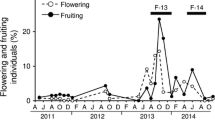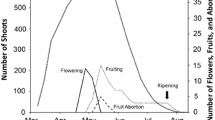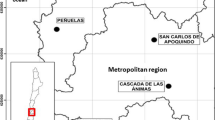Summary
The fire-prone California chaparral contains two sympatric species of shrubs: Arctostaphylos glauca and A. glandulosa. A previous study showed that in a stand where both species had similar amounts of coverage, A. glauca had fewer seeds in the soil. We attempt to answer the questions: 1) Could ground-foraging seed predators produce the lower population of A. glauca seeds in the soil? 2) Do predators select fruits randomly with respect to fruit size? 3) Do the fruits of the two species differ in the proportions of fruit components (i.e. seeds, endocarp, mesocarp, and exocarp) in ways that could be important to seed predators? Predation was measured on artificial caches of fruits, for 17 weeks. Selection by predators was examined by comparing weights of fruits recovered from soil samples with newlymatured fruits on the shrubs. Fruits components were characterized by dividing fruits into 3 fractions and weighing. More fruits of A. glauca were removed from the caches. Fruits of both species recovered from the soil were lighter than those on the shrubs. The weights of seeds, stony and fleshy fruit layers were all larger in A. glauca. Within fruits of A. glandulosa, the weights of the three components, various combinations, and ratios were all significantly correlated, while in A. glauca no other component, combination of components, or ratio examined was significantly correlated with the weights of the seeds.
Similar content being viewed by others
References
Axelrod, D.I.: History of the mediterranean ecosystem in California, pp. 225–277. In: Mediterranean type ecosystems: Origin and structure. Ecological studies (F. diCastri, H.A. Mooney, eds.), Vol. 7. Berlin-Heidelberg-New York: Springer 1973
Baker, H.C.: Seed weight in relation to environmental conditions in California. Ecology 53, 997–1010 (1972)
Brown, J.H., Lieberman, G.A.: Resource utilization and coexistence of seed-eating desert rodents in sand-dune habitats. Ecology 54, 788–797 (1973)
Dixon, W.G., Massey, F.J., Jr.: Introduction to statistical analysis, 3rd ed., 638 pp. New York: McGraw-Hill 1969
Hanes, T.L.: Succession after fire in the chaparral of Southern California. Ecol. Monogr. 41, 27–52 (1971)
Harper, J.L., Williams, J.T., Sagar, G.R.: The behavior of seeds in soil. I. The heterogenity of soil surfaces and its role in determining the establishment of plants from seed. J. Ecol. 53, 273–286 (1965)
Horton, J., Kraebel, C.: Development of vegetation after fire in the chamise chaparral of Southern California. Ecology 36, 244–262 (1955)
Horton, J.S., Wright, J.T.: The wood rat as an ecological factor in Southern California watersheds. Ecology 25, 341–351 (1945)
Jameson, E.W.: Food of deer mice, Peromyscus maniculatus and P. boylei, in the Northern Sierra Nevada, California. J. Mammal. 33, 50–60 (1952)
Janzen, D.H.: Seed-eaters versus seed size, number, toxicity and dispersal. Evolution 23, 1–27 (1969)
Janzen, D.H.: Seed predation by animals. Annu. Rev. Ecol. Sys. 2, 465–492 (1971)
Jepson, W.L.: Regeneration in manzanita. Madroño 1, 3–11 (1916)
Jepson, W.L.: A Flora of California, Vol. 3, pp. 21–51. Associated Students Store, University of California (1939)
Keeley, J.E.: The adaptive significance of obligate-seeding shrubs in the chaparral. M.S. Thesis, California State University, San Diego, California, 82 pp. (1973)
Plumb, T.R.: Sprouting, of chaparral by December after a wild-fire in July. U.S. Forest Serv., Pacific Southwest Forest and Range Exp. Sta. Tech. Paper 57, 12 pp. (1961)
Rosenzweig, M.L., Sterner, P.W.: Population ecology of desert rodent communities: body size and seed-husking as bases for heteromyid coexistence. Ecology 51, 217–224 (1970)
Salisbury, E.J.: The reproductive capacity of plants, 244 pp. London: Bell 1942
Smigel, B.W., Rosenzweig, M.L.: Seed selection in Dipodomys merriami and Perognathus penicillatus. Ecology 55, 329–339 (1974)
Smith, C.C.: The coevolution of pine squirrels (Tamiasciurus) and conifers. Ecol. Monogr. 40, 349–371 (1970)
Smith, C.F.: The fall food of brushfield pocket mice. J. Mammal. 23, 337–339 (1942)
Wells, P.V.: Vegetation in relation to geological substratum and fire in the San Luis Obispo quadrangle, California. Ecol. Monogr. 32, 89–103 (1962)
Wells, P.V.: The relation between mode of reproduction and extent of speciation in woody genera of the California chaparral. Evolution 23, 264–267 (1969)
Wells, P.V.: The manzanitas of Baja California, including a new species of Arctostaphylos. Madroño 21, 268–273 (1972)
Author information
Authors and Affiliations
Rights and permissions
About this article
Cite this article
Keeley, J.E., Hays, R.L. Differential seed predation on two species of Arctostaphylos (Ericaceae). Oecologia 24, 71–81 (1976). https://doi.org/10.1007/BF00545488
Received:
Issue Date:
DOI: https://doi.org/10.1007/BF00545488




